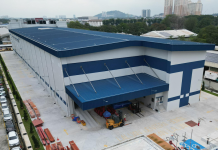Clariant’s state-of-the-art healthcare packaging production facility in Cuddalore in Tamil Nadu is expected to be operational in the second semester of 2017. The FDA-compliant plant, which primarily aims at supporting the growing pharmaceutical packaging market in India, will begin with the production of desiccant canisters and make a significant contribution to Clariant’s global desiccant canister production capacity. Clariant has invested approximately Rs. 70 crore in the new plant, which is the first ever greenfield Clariant plant in India.

“Providing sufficient capacity to meet the growing industry demands as well as export to other markets in the world will be ensured by the Cuddalore plant. The plant will be a significant contributor to Clariant’s global desiccant canister production, and along with the other primary production site in the USA for desiccant canisters, it will provide customers with Business Continuity Planning (BCP),” says Ketan Premani, managing director, Clariant Medical Specialties India Limited.
Clariant’s healthcare packaging unit offers solutions that help protect healthcare products from humidity and oxygen by designing and manufacturing controlled atmosphere packaging. Its broad portfolio includes desiccant canisters which can be inserted at high rates of speed on high velocity packaging lines. These canisters are most widely used in the pharmaceutical industry as they also meet the safety standards of food and drug administrations in the US, EU and other major regions.
Trends in pharmaceutical packaging
Talking about some of the trends in the Indian and global pharmaceutical packing segment, Premani says that the global healthcare sector is enjoying enhanced focus, especially in developing countries.
“The industry is focusing on safety and integrity of the drugs as it is extremely vital to maintain the shelf life of the drugs. Globally the healthcare industry has seen a shift in paradigm and is now skewed towards effective and meaningful packaging. The global healthcare sector is seeking active packing options to provide drug stability since these drugs become susceptible to moisture and oxygen present in the atmosphere,” he says.
Commenting on the domestic market, he says that the Indian pharmaceuticals market is expected to grow at a CAGR of 18% by 2020. This will increase the need for pharmaceuticals packaging in India, which is projected to grow at a CAGR of 5.46% till 2020. Because of the rise in pharmaceutical manufacturing in China and India, Asia Pacific is anticipated to grow rapidly. “With an extensive range of medicines available for exports clubbed with the largest number of approved pharmaceutical manufacturing facilities, India is poised to take the lead in pharmaceutical exports to the world. Hence, adhering to global regulations such as USFDA is very essential. In fact, the USFDA has set up a regional office in India in the wake of the fast-growing Indian pharmaceutical industry,” shares Premani.
Tackling counterfeiting
Counterfeiting of drugs is a growing concern in the industry, with experts trying to find innovative solutions to beat counterfeiters. Rising instances of pharmaceutical counterfeiting are potentially putting at risk the health of millions of patients who purchase medicines solely on faith, believing what they are buying is genuine. Pharma packaging plays a crucial role in preventing the counterfeiting of sensitive and vulnerable products.
Clariant as a stakeholder in the industry has been working towards making counterfeiting as hard as possible. Last year, through its collaboration with SICPA, Clariant has come up with a new plastic-based anti-counterfeiting system called Plastiward for plastic pharmaceutical packaging as well as medical devices. Plastiward is designed to deliver security assessment, definition of needs, security system design, system deployment and on-going performance monitoring. It provides end-to-end solutions integrating exclusive, proprietary security features from SICPA into polymer compounds or concentrates from Clariant.
“The collaboration with SICPA further enhances and secures packaging of medical devices and pharmaceuticals as it combines the knowledge of Clariant on formulations for products needed in the Indian market, with SICPA’s expertise to deploy the security systems to authenticate and monitor,” says Steve Duckworth, head of Global Segment Healthcare Polymer Solutions, Clariant.











